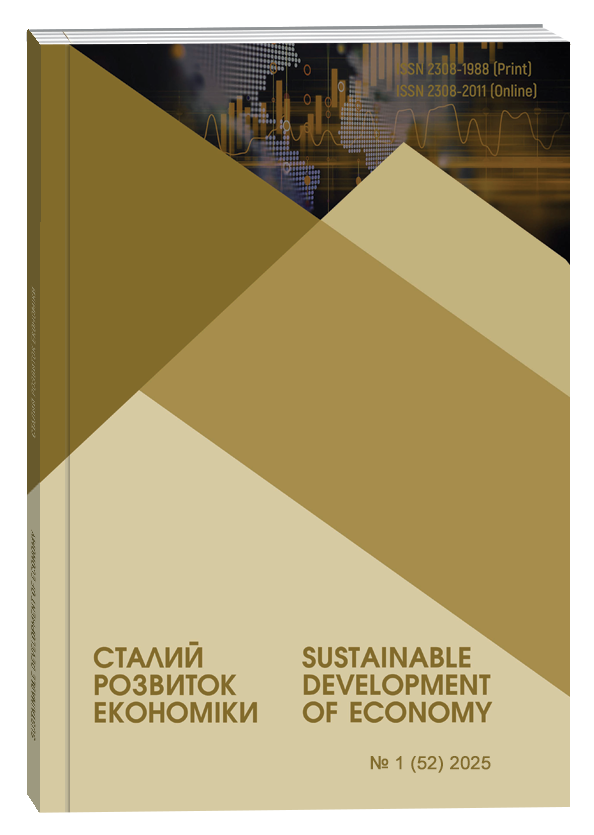ПРИБУТКИ Й ІНВЕСТИЦІЇ УКРАЇНСЬКИХ ПІДПРИЄМСТВ В КОНТЕКСТІ ПОЛІТИКИ СТАЛОГО РОЗВИТКУ
Анотація
Стаття присвячена оцінці схильності українського бізнесу генерувати вигоди для контрагентів та стейкхолдерів своєї діяльності через інвестування одержуваних прибутків в капітальні активи. Для оцінювання була побудована модель функціонального зв'язку між усередненими за три роки розмірами чистого прибутку підприємств і розмірами усереднених за три роки інвестицій в капітальні активи, що фінансувались за рахунок власних ресурсів підприємств. Отримані емпіричні свідчення на користь того, що зв'язок між динамікою інвестицій по групах великих, середніх і малих підприємств має компенсаторний характер: більші прирости по одній групі компенсуються меншими по інших і сукупні коливання вирівнюються. Також отримано підтвердження високої чутливості профінансованих власними ресурсами підприємств капітальних інвестицій до розмірів отримуваних прибутків. Це тлумачиться як свідчення на користь великого потенціалу тих важелів політики сталого розвитку, що заохочують підприємства активно генерувати вигоди для контрагентів та стейкхолдерів своєї діяльності, використовуючи можливості, зумовлені зростанням обсягів прибутків. Зокрема, оскільки гранична і середня схильність бізнесу інвестувати отримані прибутки вище одиниці, можна очікувати, що податкові пільги, виявляться ефективним (з позицій зростання суспільного добробуту) засобом стимулювання інвестиційної активності бізнесу.
Посилання
Stevens C. Linking sustainable consumption and production: The government role. Natural Resources Forum. 2010. No. 34. P. 16-23. DOI: https://doi.org/10.1111/j.1477-8947.2010.01273.x
Stankeviciute Z., Kunskaja S. Towards to sustainable development: theoretical research. Research Journal. 2021. No. 26. P. 202-220. DOI: https://doi.org/10.13165/PSPO-21-26-01
Weimer, David Leo, and Aidan R. Vining. Investing in the Disadvantaged: Assessing the Benefits and Costs of Social Policies, Georgetown University Press. 2009. 304 p. DOI: https://doi.org/10.1353/book13038
Лукьяненко Д.Г. (ред) та ін. Глобальное экономическое развитие: тенденции, асимметрии, регулирование: монография. Київ : КНЕУ, 2013. 466 с.
Adam T., Goyal V.K. The investment opportunity set and its proxy variables. Journal of Financial Research. 2008. No. 31(1). P. 41-63.
Kornet K. European Union Funds as a Source of Financing the Companies Investments. Contemporary Economics. 2008. No. 2. P. 5–20.
Economic Policy Uncertainty, Marketization Level and Firm-level Inefficient Investment: Evidence from Chinese Listed Firms in Energy and Power Industries. Hou F. et al., Energy Economics. 2021. No. 100. P. 105–153.
Geng X.Y. Contradiction Analysis of NPV and IRR in Investment Decision. Beijing Wuzi University. 2021. 122p.
Magni C.A. Investment Decisions, Net Present Value and Bounded Rationality. Quantitative Finance. No. 9(8). P. 967-979.
Гук О.В., Мохонько Г.А., Шендерівська Л.П. Тенденції інвестування в Україні. Економіка та суспільство. 2021. № 29. URL: https://economyandsociety.in.ua/index.php/journal/article/view/577
Караван Н.А. Класифікація інвестицій та обґрунтування вибору критеріїв їх ефективності. Інвестиції: практика та досвід. 2019. № 1, C. 13–17.
Koreniuk P., Kopyl O. Conceptual approaches and methods for determining the investment attractiveness of the national economy. Economic journal of Lesia Ukrainka Eastern European National University. 2018. Vol. 14. No. 2. P. 56–62.
Modigliani F., Miller M. H. The cost of capital, corporation finance and the theory of investment. The American Economic Review. 1958, No. (6)268. P. 122–156.
Papaioannou S. Public Investment Multipliers in EU Countries: Does the Efficiency of Public Sector Matter? Athens: Centre of Planning and Economic Research. 2016. DOI: https://doi.org/10.2139/ssrn.2755247
Scandizzo P.L., Pierleoni M.R. Short and Long-Run Effects of Public Investment: Theoretical Premises and Empirical Evidence. Theoretical Economics Letters, 2020. No. 10. P. 834-867. https://doi.org/10.4236/tel.2020.104050
Azariadis C. Riddles and Models: A Review Essay on Michel De Vroey’s “A History of Macroeconomics from Keynes to Lucas and Beyond”. Journal of Economic Literature. 2018. No. 56, P. 1538-1576. DOI: https://doi.org/10.1257/jel.20181439
Myers S., Majluf N. Corporate Financing and Investment Decisions When Firms Have Information that In-vectors do not Have. Journal of Financial Economic, 1984. No. 2. P. 187-221.
Державна служба статистики України. Статистка діяльності підприємств. URL: https://www.ukrstat.gov.ua/
Садовська І., Нагірська К. Амортизаційна політика як джерело інвестиційної безпеки підприємств: обліково-фінансовий вимір. Економіка та суспільство. 2024. No. 59. DOI: https://doi.org/10.32782/2524-0072/2024-59-167.
Герасименко І., Зубченко В. Роль і місце амортизації у формуванні інвестиційних ресурсів сільськогосподарських підприємств. Сталий розвиток економіки. 2016. No. 3(32). C. 103-108. URL: https://www.economdevelopment.in.ua/index.php/journal/article/view/374
Stevens, C. (2010). Linking sustainable consumption and production: The government role. Natural Resources Forum, no. 34, pp. 16-23. DOI: https://doi.org/10.1111/j.1477-8947.2010.01273.x
Stankeviciute, Z., & Kunskaja, S. (2021). Towards to sustainable development: theoretical research. Research Journal, no. 26, pp. 202-220. DOI: https://doi.org/10.13165/PSPO-21-26-01
Weimer, David Leo, and Aidan R. Vining (2009) Investing in the Disadvantaged: Assessing the Benefits and Costs of Social Policies. DOI: https://doi.org/10.1353/book13038
Lukyanenko D. G. (ed.) and others (2013). Hlobalnoe эkonomycheskoe razvytye: tendentsyy, asymmetryy, rehulyrovanye: monohrafyya [Global Economic Development: Trends, Asymmetries, Regulation: Monograph]. Kyiv: KNEU, 466 p. (in Ukrainian)
Adam, T., & Goyal, V. K. (2008). The investment opportunity set and its proxy variables. Journal of Financial Research, no. 31(1), pp. 41-63.
Kornet, Katarzyna (2008) European Union Funds as a Source of Financing the Companies Investments. Contemporary Economics, no. 2, pp. 5–20
Hou, F., Tang, W., Wang, H., & Xiong, H. (2021). Economic Policy Uncertainty, Marketization Level and Firm-level Inefficient Investment: Evidence from Chinese Listed Firms in Energy and Power Industries. Energy Economics, no. 100.
Geng, X. Y. (2021) Contradiction Analysis of NPV and IRR in Investment Decision. Beijing Wuzi University,
Magni, C. A. (2009) Investment Decisions, Net Present Value and Bounded Rationality. Quantitative Finance, no. 9(8), pp. 967-979.
Huk O. V., Mohonko G. A., Shenderivska L. P. (2021). Tendencii investuvannya v Ukraini. [Investment trends in Ukraine]. Economika ta suspilstvo. no. 29. Available at: https://economyandsociety.in.ua/index.php/journal/article/view/577 (in Ukrainian)
Karavan N. A. (2019). Klasifikacia investicii ta obgruntuvanna vybory kruteriiv ix efektuvnosti. [Classification of investments and justification of the choice of their effectiveness’ criteria]. Investicii: praktuka ta dosvid. no. 1, pp. 13–17 (in Ukrainian)
Koreniuk, P., Kopyl, O. (2018). [Conceptual approaches and methods for determining the investment attractiveness of the national economy]. Economic journal of Lesia Ukrainka Eastern European National University. vol. 14, no. 2, pp. 56–62.
Modigliani F. and Miller H M. (1958). The cost of capital, corporation finance and the theory of investment. The American Economic Review, no. (6), pp. 122-156.
Papaioannou S. (2016). Public Investment Multipliers in EU Countries: Does the Efficiency of Public Sector Matter? Athens: Centre of Planning and Economic Research. DOI: https://doi.org/10.2139/ssrn.2755247
Scandizzo P. L., & Pierleoni M. R. (2020). Short and Long-Run Effects of Public Investment: Theoretical Premises and Empirical Evidence. Theoretical Economics Letters, no. 10, pp. 834-867. DOI: https://doi.org/10.4236/tel.2020.104050
Azariadis C. (2018). Riddles and Models: A Review Essay on Michel De Vroey’s “A History of Macroeconomics from Keynes to Lucas and Beyond”. Journal of Economic Literature, no. 56, pp. 1538-1576. DOI: https://doi.org/10.1257/jel.20181439
Myers, S., and Majluf N. (1984) Corporate Financing and Investment Decisions When Firms Have Information that In-vectors do not Have. Journal of Financial Economic, no. (2), pp. 187-221.
State Statistics Service of Ukraine. Economic statistics. Statistics of enterprises activities. Available at: https://www.ukrstat.gov.ua/
Sadovska, І., & Nahirska, К. (2024). Amortyzatsiina polityka yak dzherelo investytsiinoi bezpeky pidpryiemstv: oblikovo-finansovyi vymir [Depreciation policy as a source of investment security of enterprises: accounting and financial dimension]. Ekonomika ta suspilstvo, no. (59). DOI: https://doi.org/10.32782/2524-0072/2024-59-167 (in Ukrainian)
Herasymenko, I., & Zubchenko, V. (2016). Rol i mistse amortyzatsii u formuvanni investytsiinykh resursiv silskohospodarskykh pidpryiemstv. [The role and place of depreciation in the formation of investment resources of agricultural enterprises] Stalyi rozvytok ekonomiky, no. 3(32), pp. 103-108. Available at: https://www.economdevelopment.in.ua/index.php/journal/article/view/374 (in Ukrainian)


